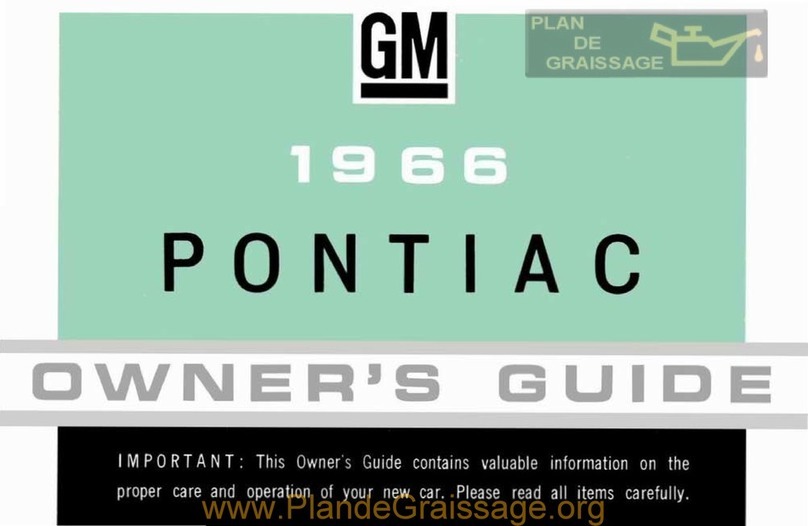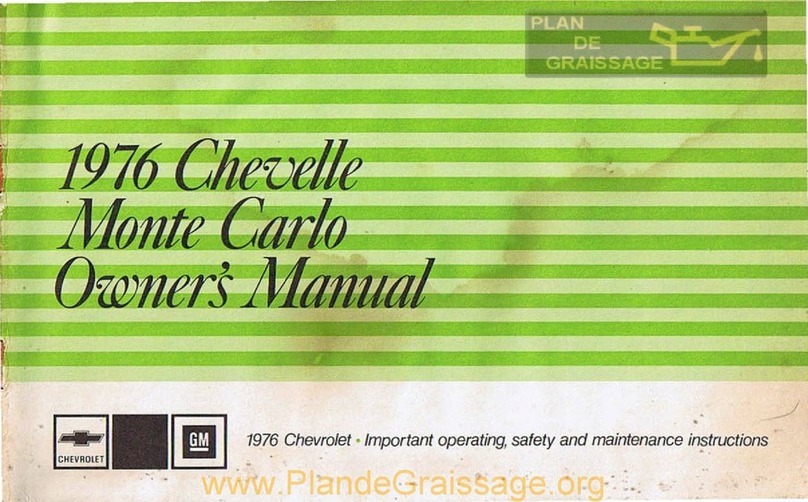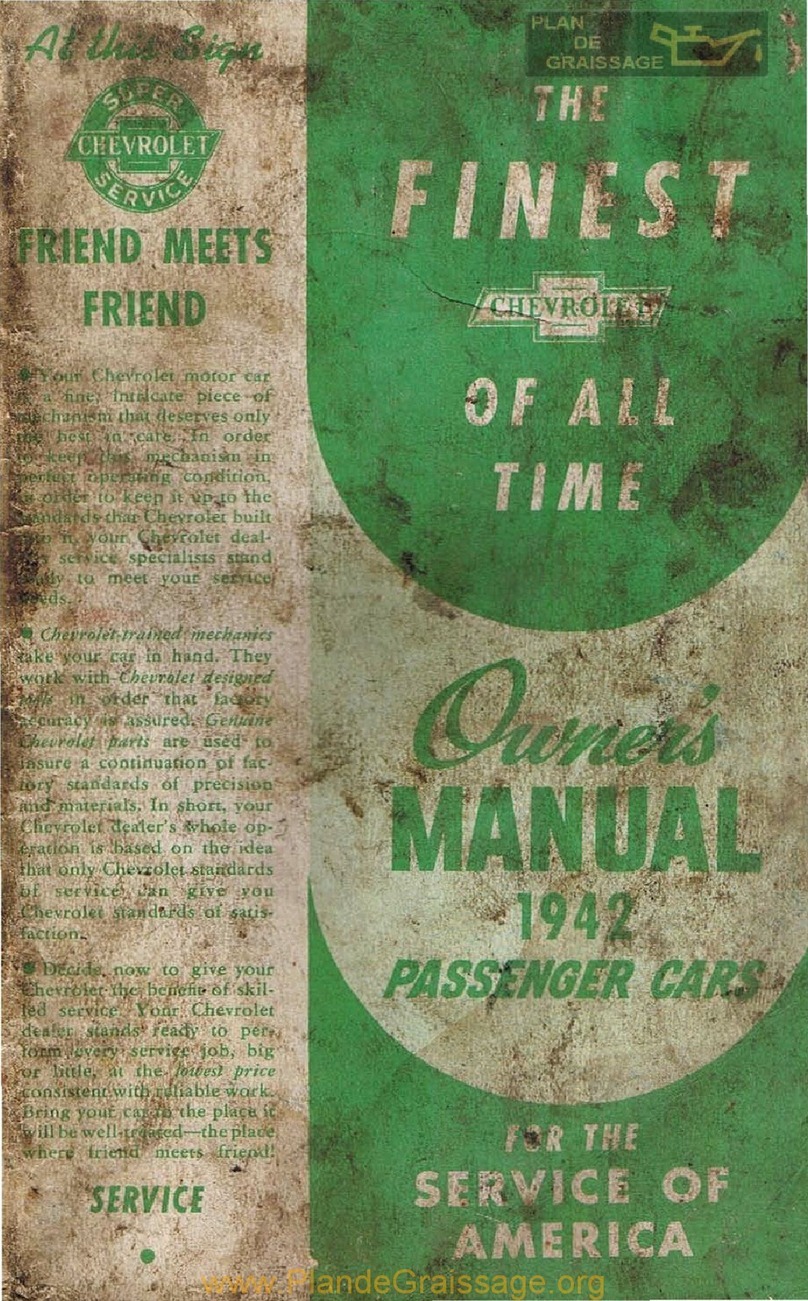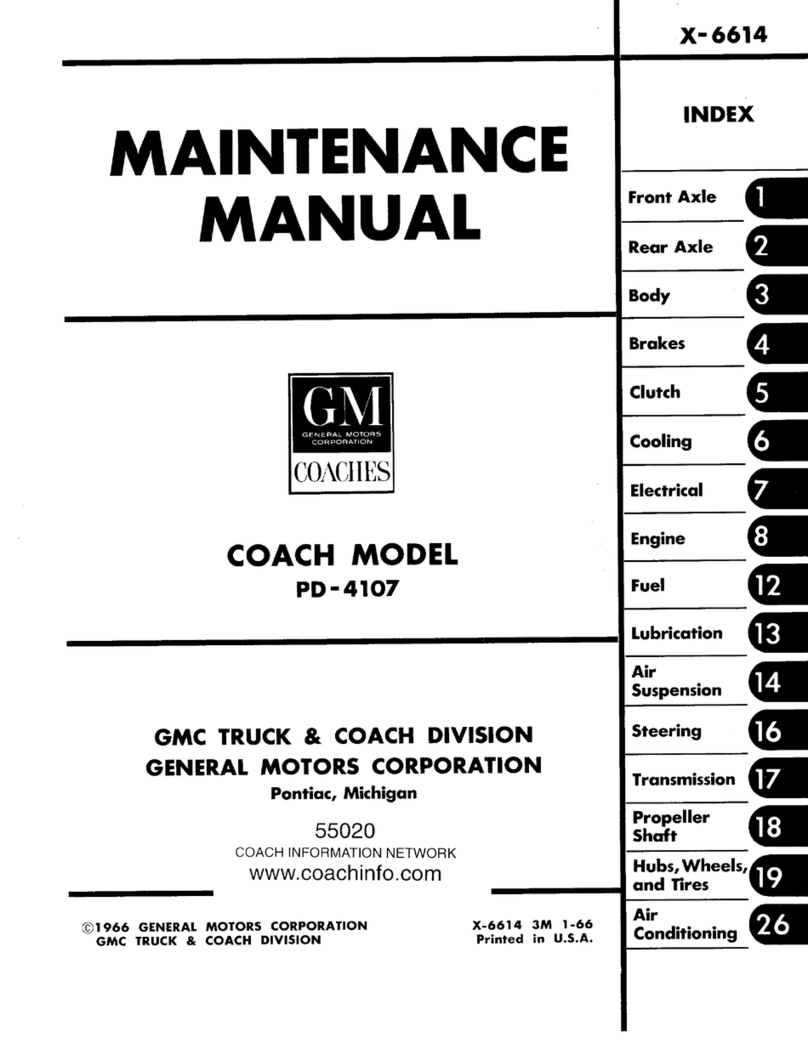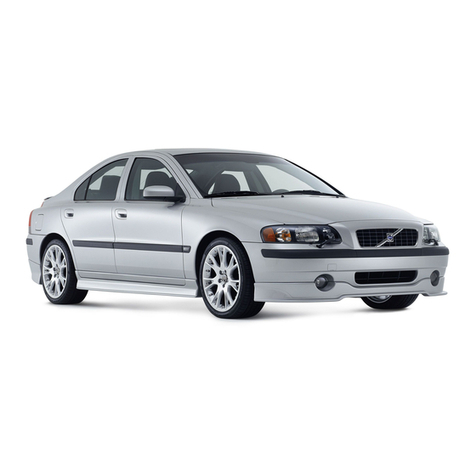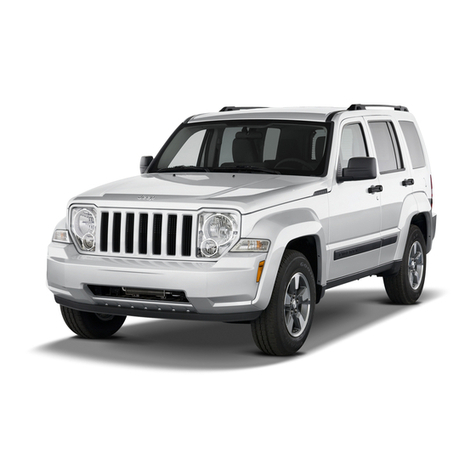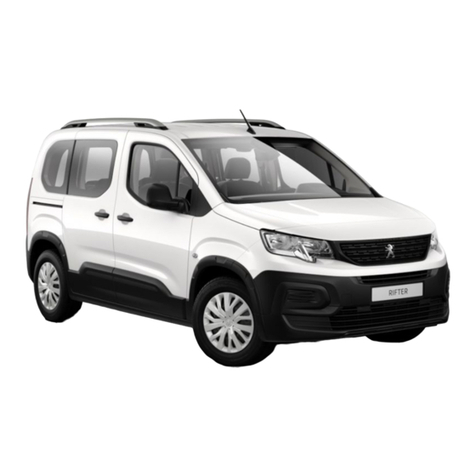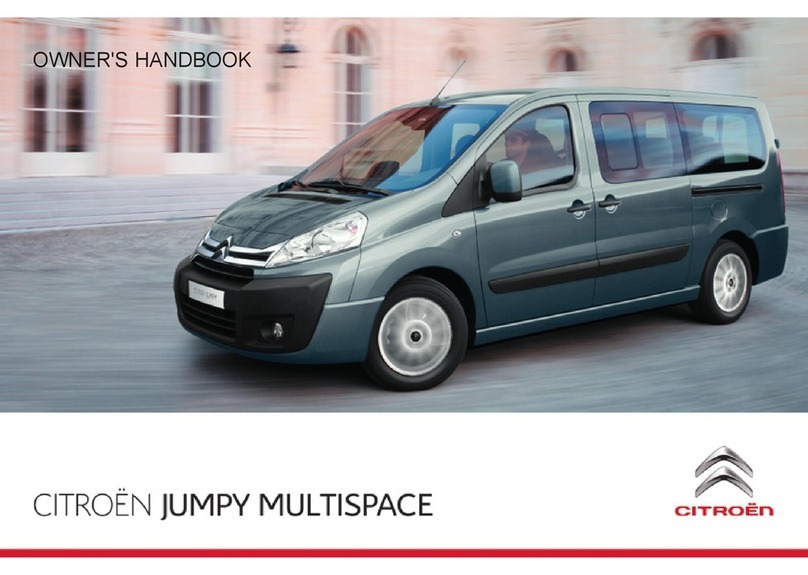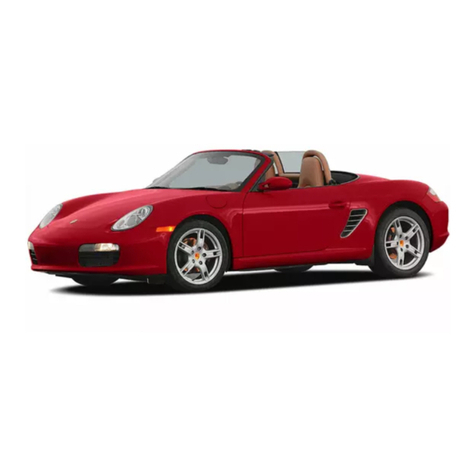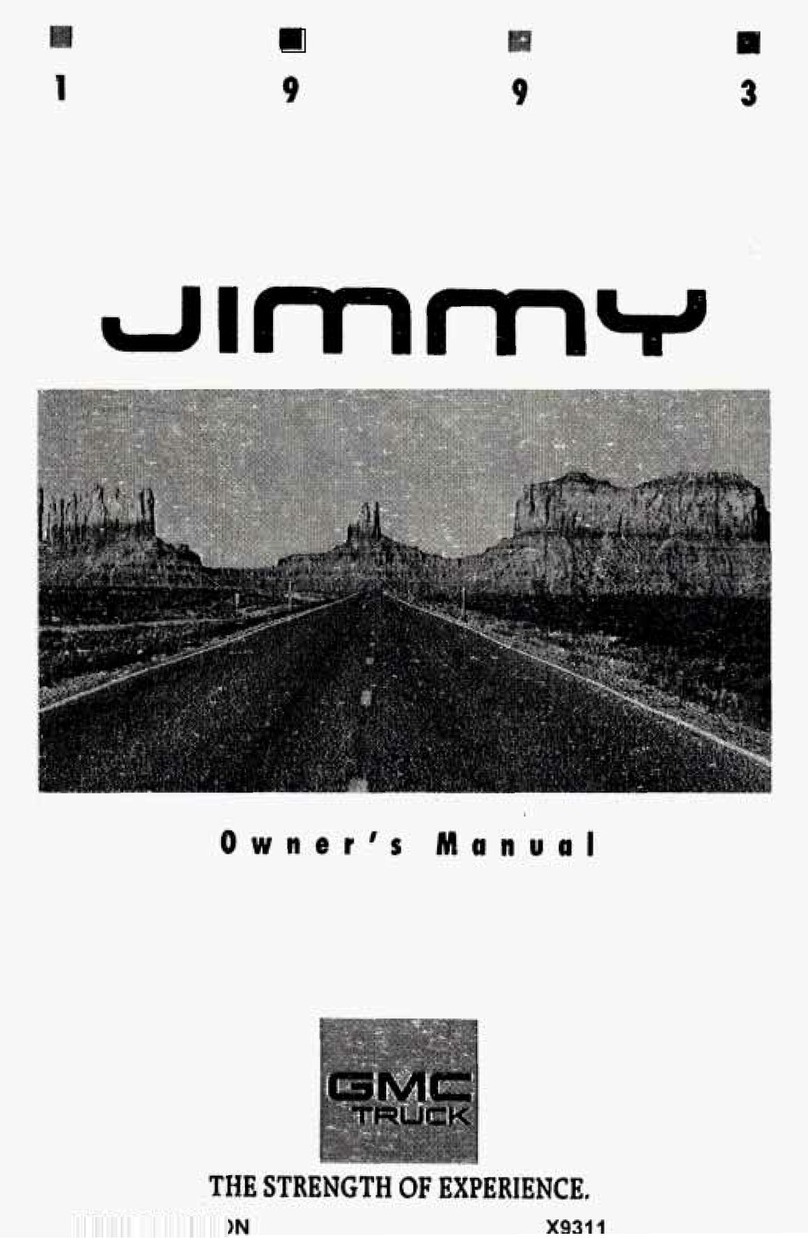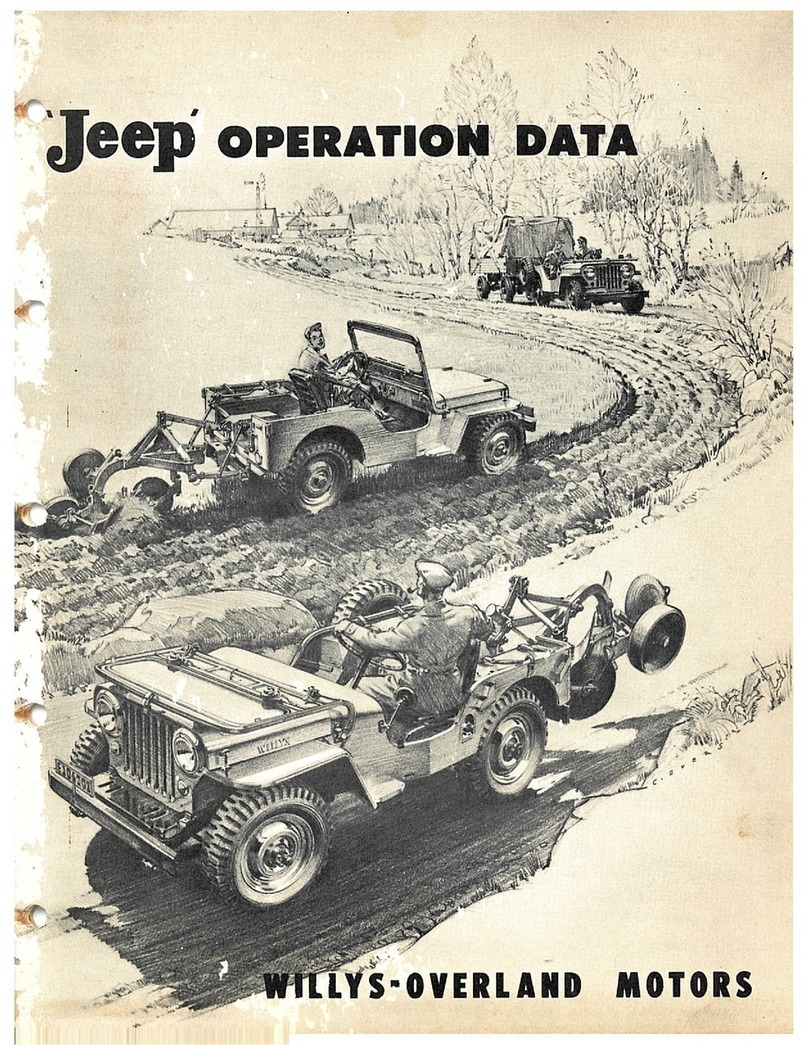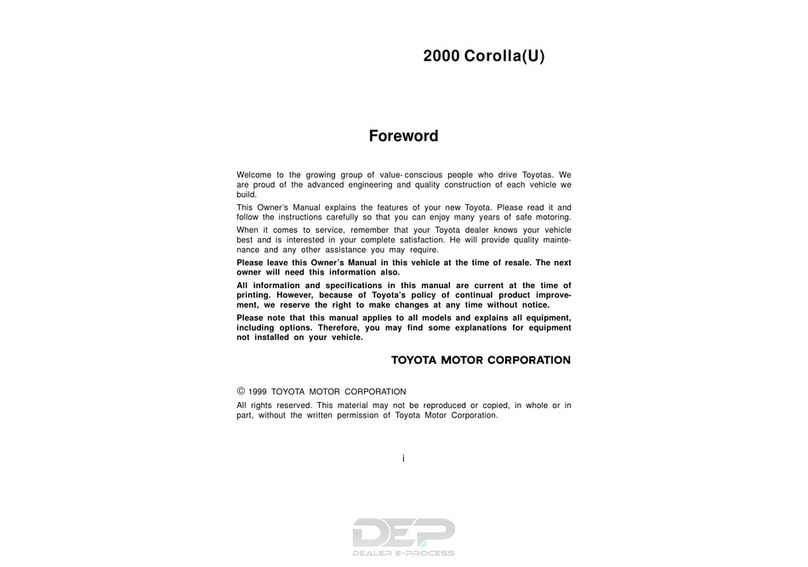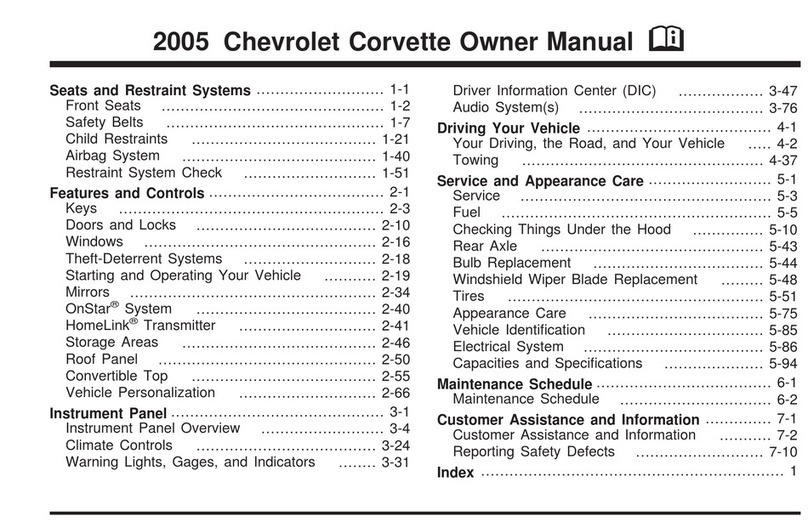GM Chevrolet 1946 User manual

CARS
www.PlandeGraissage.org

OWN
ER'SMA NUAl
_·
1946
PASSEnGER
CARS
THIRD
EDITION
Allyone desirous of
having
additional
mechanical
information
covering
the
design
.
and
construction
of
the
1946
Chevrolet
passenger
car
should
address
thei~
request
to
the
Service
and
Mechanical
Depart.
ment
at
the
addresi{shown below.
CHEVR0
LET
m0
TO
R 0IV
IS
Ion
GENERAL
MOTORS
CORPORATION
DETROIT
2, MICHIGAN
www.PlandeGraissage.org

2-
lU~_
'
lHI
nO'
0RT0 FRI
Enos
HIP
vou
have
purchased
a new
Chevrolet
car,
and
that
·<
1
purchase
means
a great'deal
to
you,
to
your
Chev-
rolet
d~al~r,
and
to
Chevrolet.
. .
To
you,
it
rn..eans
possession'
of
a fine
motor
car.
To
your
Chevrolet
dealer,
it
means
an
opportunity-and
an
obligation-to
help
you
realize
true
satisfaction
with
your
investment.
And
to
Chevrolet,
it
means
a
large
and
willing
interest
in
maintaining
your
con-
tinued
satisfaction,
for
the
entire
Chevrolet
organiza-
tion
desires
not
merely
to
_
~"ke
sales,
but
also
to
make
friends.
Our
interest
in
you, as a
Chevrolet
owner,
and
in
your
car,' as a
Chevrolet
product,
will
continue
during
all
the
months
and
years
that
you
drive
your
Chevrolet.
We
want
to
make
Chevrolet
ownership
the
most
pleasant
~~tor
car
experience-
you
have
ever enjoyed.
We ask
you
to
read
these
pages carefully.
They
are
the
key
to
abetter
and
mutu~l
understanding,
and
will
open
the
door
of
friendship
.
bet~~en
you,
your
Chev-
rolet dealer,
and
Chevrolet.
www.PlandeGraissage.org

GEnERAL
'
InFORmATIOn
MANUFACTURER'S
WARRANTY
It is expressly agreed·
that
there
are
no
.
warranties,
e;p~~;~~d&
'.~.
implied,
made
by either
the
Dealer
or
the
Man~f~ct\iter6n
ellev-
'. .
rolet
motor
vehicles, chassis
or
parts
furnished
hereui1~r,
except
the
Manufacturer's
warranty
against defective m.
aterialsorwork-
·
.
manship
as follows: . .
"The
Manufacturer
warrants
eachnew
m~~or
v~hicie,including
all
equipment
or
accessories (except tires) supplied
by
th'eManu-
facturer, chassis
or
part
manufactured
by..it
to
be
free from
defects
in
material
and
workmanship
under
normal
use
and
service, its obligation
under
this
warranty
being limited
to
mak-
ing good
at
its factory
any
part
or
parts
thereof
which
shaU,
within
ninety
(90) days after delivery
of
such
vehicle
to
the
original
purchaser
or
before
such
vehicle
has
been
driven
4,CXXl
miles,
whichever
event
shall
first occur, be
returned
to
it
,
with
transportation
charges
prepaid
and
which
its
examination
"
.
~
....
,:
~
shall
disclose
to
its
satisf¥.oh
to
have
been
thus
defective;
this
warranty
being expressly
in
lieu
of
·all
other
warranties, ex-
'.
pressed
or
implied,
and
.all
other
obligations
or
li'abilities
on
its
part,
and
it
neither
assumes
nor
authorizes
any
other
person
to
assume for
it
any
other
liability
in
connection
with
the
sale
of
its vehicles.
"This
warranty
shall
not
apply
to
any
vehicle
which
shall
have
been
repaired
or
altered
outside
of
an
authorized
Chevrolet
Service
Station
in
any
way
so
as
in
the
judgment
of
the
Manu-
facturer
to
affect its stability
and
reliability,
nor
which
has
been
subject
to
misuse, negligence
or
accident."
* * *
The
Manufacturer
has
reserved
the
right
to
make
changes
in
design
or
add
any
improvements
on
motor
vehicles
and
chassis
at
any
time
without
incurring
any
obligation
to
·install
motor
vehicles
and
chassis
previously
purchased.
• 3
..
www.PlandeGraissage.org

TIRE
WARRANTY
The
tires
that
came
with
your
car
are
guaranteed
by
the
tire
manufacturer,
or
his
agent,
according
to
the
standard
Tire
Manu-
facturer's
Warranty.
OWNER
SERVICE
POLICY
The
Chevrolet
dealer
agrees
to
promptly
perform
and
fulfill
all
of
the
terms
and
conditions
of
the
"Owner
Service Policy" .
whi~h
was given
to
you
at
the
time
you
took
delivery
of
your
new
Chevrolet
car.
REPAIR PARTS
Genuine
Chevrolet
parts
manufactured
to
the
same
rigid
specifications as
the
parts
used
in
the
original
assembly
of
the
car,
are
carried
in
stock
by
Authorized
Chevrolet
Service
Stations.
Use
only
Genuine
Chevrolet
parts
for
replacement
purposes,
because
they
are
better
.
They
aresold
at
uniform
prices
through-
out
the
United
States.
Printed
price lists
published
by
the
Chev-
rolet
Motor
Division
are
open
to
the
inspection
of
owners
at
any
Authorized
Chevrolet
Dealer's
establishment.
SERVICE
CHARGES
Charges
prevailing
at
Authorh~
ff
Chevrolet
Service
Stations
are
based
on
Flat
Rate
schedules
furnished
by
the
Chevrolet
Motor
Division.
These
Flat
Rates
are
based
on
the
use
of
methods
and
tools
approved
by
the
Chevrolet
Motor
Division,
assuring
the
highest
quality
of
work
at
the
lowest possible price
consistent
with
this
quality.
Protect
your
investment
by
having
your
replacement
repair
and
maintenance
work
done
by
an
Authorized
Chevrolet
Service
Station,
which
has
all
the
necessary
tools
and
the
factory-trained
men.
GENUINE
CHEVROLET
ACCESSORIES
The
materials
used
in
the
manufacture
of
these
accessories
are
of
the
highest
and
finest quality.
These
accessories will
appeal
to
every
discriminating
Chev-
'··
.,
rolet
buyer.
They
offer
him
the
opportunity
to
show
his
indi-
vid!1ality
in
the
selection
of
added
touches
of
refinement
and
•
luxury
for
his
car.
,
.Th~Yarecarried
in
stock
by
all
Chevrolet
Dealers.
4 • t
··"
",
www.PlandeGraissage.org

BREAHlnG-ln
PERIOD
Your
Chevrolet
car
has
been
designed
to
furnish
you
many
thousands
of
miles
of
motoring
pleasure.
In
order
to
maintain
its
high
standard
of
performance
and
efficiency, special care
should
be
given
for
the
first
two
thousand
miles as
to
the
speed
at
which
the
car
is
driven
and
also
to
lubri-
action.
To
properly
break
in
the
moving
parts
of
the
car,
do
not
drive
faster
than:
40 Miles
per
hour
for
the
first 100 Miles
50 Miles
per
hour
for
the
next
200 Miles
60
Miles
per
hour
for
the
next
200
Miles
Continuous
high
speed driving
should
not
be
attempted
until
the
car
has
been
driven
2000
miles.
See
that
your
car
is
lubricated
at
regular intervals
in
accord-
ance
with
the
recommendations
under
"General
Lubrication."
WAY
S T
oJ'av
E
GA
SAn
0 0IL
How
many
miles
do
you
get
to
the
gallon? Unless you are
the
exception,
you
can
get still greater mileage.
And
without
cost!
Just eliminate a few
of
the
faults
which
most
of
us
have
and
which
tend
to
waste gasoline
and
oil.
Some
of
the
most
coinmon
ones
are listed here.
Study
them~
Correct
them
and
you'll
save
on
fuel bills.
Quick Get-Aways are thrills
that
cost
money.
Tramping
suddenly
on
the
accelerator,
or
pumping
it,
feeds
your
motOr
more
gasoline
that
it
can
use.
Quick
get-aways,
too,
waste gasoline by carrying
you
too
far
in
second
gear.
Get
away easily
and
smoothly
to
save gasoline. Slip
into
high
gear
at
20
to
25
miles
per
hour.
Sudden Stops are sometimes necessary,
but
always use
extra
gasoline.
Stopping
gradually,
with
the
engine
braking, saves gas
money-and
brake
lining, too.
-5
. ;
www.PlandeGraissage.org

lire,
more
than
dangerous.
At
70 miles
per
hour
<
..
,'
yourmotor
us.es
almost twice as
much
gasoline,
to
gq
~
otie
,
rtllle,as
it does
at
20 milespei:
hour.
Economical cruising
speeas
are30to45
M).H.
:
S~ftTites
are
hlj.rd
on
you
t
g~soline
bill.
They
mean
more
road
'
friction.
This
gives
your
motor
unnecessary
work
to
go
and
mal<es
it
use
extra
gas.
Keep
the
extra
money
in
your
pocket
by
keeping
your
tires
inflated
to
the
recommended
pressures.
Parking
in
the
'
Sun
wastes gasoline.
Park
your
car
in
the
shade,
if
you
can,
so
that
the
hot
sun
will
not
evaporate
gas
from
your
tank.
An
. Idling
Motor
is
a useless expense.
Turn
it
off while
you
~re
waiting
at
the
'
curb
for a friend,
or
at
a
train
crossing.
,
An
I"efficient Carburetor is
an
efficient gasoline waster.
Have
, , yours
ch~cked
at
least twice a
year
(for
summer
and
~
winterdriving)
to
be
sure
it
is properly adjusted,
that
the
octane
selector is properly set,
and
that
the
sediment
bulb
'is
dean.
Cheap lubrication is a waste
ofm'oiiey.
Use
oil
of
good
quality
,
and
of
the
g
rade
specified by
the
manufac-
turer.
Have
your
car
well
gr~ased
every
thousand
miles.
One Faulty or Dirty Spqrk
Plug
may
waste
much
of
your
," .
"
gasohne
.
"
--. .
','
An
Over-Full Crankcase wastes oil
and
does
not
~ive
you
better
, ,
lubrication,
despite theories
you
may
have
heard.
Keep
your
oil
level
within
<
the
limits
marked
on
the
<<
oHgau~e
rod
in
the
crankcase.
to
Obtain Maximum Efficiency
and
greatest gas mileage,
have
;"
" . a complete
motor
tune-up
per-
,~
formed
every
5,009 miles
or
at
least twice a year.
www.PlandeGraissage.org

,
The
followi'ng
table
will i
ndica
te
some
of
t
he
things
which
.
sho~;d
'
be
done
atr~u~~
P
":::
7;;~
_
mileage
interv
als
to
ass
ure
your
receiving
the
maximum,
not
only
in
performance,
but
in
"'
},!
~
1
economy.
'
~ ~~;;"E
;~
____
..,....
__
......,
___
-,-
___
"i-
__
--,_=--'+
__
-.,...-_....;.,-----+....;.,-"-
'
''''
'.;'.~
'''
1
Mileage
LC~
~i~s~~e
C~ijge
Cki~n ~~:~k
g~~
~e
~~~~
t
.
E~~r;e
I~~~~!ie;~~~~
>:"·:',
?
J
* t Cleaner Plugs
Tires
Absorbers
Dealer
Bea
rin
gs '·
---
:
<::
1
----'--
1
----
- -
------
- - _
__
_.
__
_ _
__
__
_.
____
. _ ,_'
_
~,
.'
-
~;-~~?
~
500
•
"----1-
- - - - .- -
--
--
----
--
- - '- - -.
___
'
_'
_ _ . '_,_ '_.
1000
•
-
--
-
----
---
-----
- -
----
--
----
---------
--
-
2000
• • •
- - - - 1
--
-
--
--
.
----
. - .
-------------
,
--
3000
• • •
----
'I--
-
-
------
---
--
--
-
~
------
--
4000
• • •
-~--I---------
·
------
,-.
----~------
-'--
-
..
-
5000
• • • •
_-
-
-1----
-----
- - - - - - - -
--
-
--
---
- -
6000
• • • • •
7000
•
----1
---
-
--
- -
--
-
---------------
_·
_-
8000
• • •
-I:: .! .1.· · -. -.-
..
.
- - -.
-----------.
--
-
.
~
'
'=:c---
-
-
.
-
--'--
.- -
--.
---
11000
• .
....
- -
--
1
---
--
- - - -
-------
-
--
-
---
- -
--
12000
• • • • •
-
--
-1---
---
--
--
-
--
-
--
-
-----
- -
---
13000
•
14000
• . ' • I
15000
-.
- - - , ,- -1-.-1---;--' -
.-1-.
---
.-
-- '
*
For
complete
instructions,
see'
Chart
on
pages 56
and
57.
t Felr
complete
recommendations
on
changin
g
ail
and
the
prop
er
grade
of
oil
to
lise
see pages 45
to
52.
The
following
operations
should
be
done
as
indicated:-
Check Check
Air
Change
Re
ar
Change
Add
Anti- Flush
Coo
l-
Period
Battery
In Tires Axle Lub,
Trans
.
Lub.
Freeze
ing'Sy
·
ste
m
Weekly • •
..
, ;
Spring
• • .:'
Fall • • • e
y-?
, .
~~_
;::v
.
.
..
/ .
:~
www.PlandeGraissage.org

SAFETY
BUILT
In
YOUR
CAR
Your
Chevrolet
has
be
en
designed
and
built
to
give
you
many
thousands
of
miles
of
driv
ing pleasure
and
comfort.
The
body
is
of
all-steel
construction,
well ,
insulated
against
heat
and
sound.
The
interior
appointments
have
been
made
to
'
assure
comfort
and
saf
ety.
The
adjustable
front
seat,
safety
glass,
controlled
ventilation,
and
recessed
control
knobs
on
the
instrument
panel
are examples
of
this
safety
in
design.
The
headlights are
controlled
by
the
left foot
when
changing
from
the
upper
to
the
lower beam,
which
leaves
the
right
foot
,
and
both
hands
free
to
control
the
car. Always use
the
low
beam
when
approaching
and
passing
another
car
.
,
The
hydraulic
brakes
are
the
safest
and
most
dependable
sys-
tem
of
brakes
ev
er
used, exerting
equal
brake
pressure
on
all
four
wheels.
The
hand
brake
lever,
under
the
instrument
panel
to
the
left
of
the
steering wheel, is easily reached.
HIGHWAY
SAFETY
One
of
the
most
important
aspects
of
motoring
these
days
is
motoring
safety. Safety campaigns are
constantly
being
held
in
the
major
cities.
Many
states
now
have
compulsory
inspec-
tion
laws.
Various
commissions
have
been
appointed
to
study
,
the
problem
and
make
further
recommendations
to
legislative _
bodies.
.'
The
primary
responsibility for traffic safety lies
with
the
motor
car
driver.
The
most
competent
driver always keeps
in
mind
the
other
fellow. Always signal
the
ot
,
her
driver
to
let
him.know
when
you
are
goin~
to
stop,
make
a
turn,
or
pull
away
from
the
curb.
Proper
signaling will
do
away
with
one
of
the
most
dangerous
traffic
h~zards-the
sudden,
unexpected
move.
" _,
The
State
Highway
Departments,
Automobile
Clubs,
and
.
car
~anufacturers
work
together
in
designating highways
through
'
'';'''
'
'
y~",ious
types,
of
road
,
markers
to
make
driv
,ing safer.
'
:-
~;~
8 • ;' "
www.PlandeGraissage.org

You,
th~
driver,
should
always obey these markers.
Extra
care
should
be used
at
night-particularly
when
driving
over
strange
roads.
Be
constantly
alert
and
drive
courteously.
Downhill
When
driving
down
a steep grade,
it
is advisable
to
shift
into
second
gear
and
sometimes
into
first
gear.
This
will allow
the
motor
to
act as a
brake
on
the
car
and
will
not
only
assist materially
in
keeping
the
car
under
control,
but
also
reduce
tht;. wear
on
brake
shoe
facings
and
brake
drums.
Uphln
When
driving
up
a steep grade,
it
is advisable
to
shift
into
second
gear.
This
will
avoid
placing,
undue
strain
on
the
motor
and
clutch
and
is also
more
economkal
on
the
gasoline.
Overtaking
and
passing a
car
on
a hill
or
curve
is
dangerous
as
you
cannot
,see
another
car
approaching.
Starting
on
a Hill
When
it
is necessary
to
start
your
car
on
a
hill,
you
will find
it
much
easier if, before
starting,
you
set
the
hand
brake
lever
to
keep
the
car
from
rolling
backward.
Put
the
shifting lever
in
first speed, gradually release
the
clutch,
press
down
th~~J;elerator,
and
when
the
car
starts
to
move
forward,
or
the
engine
starts
to
labor,
slowly release
the
hand
brake
lever.
Curves
When
approaching
a curve,
do
not
cross
over
the
center
of
the
road
to
pass a
car
ahead
of
you. Before
entering a curve,"slow
down
to
a safe speed
and
make
the
turn
into
the
curve
at
the
extreme
right side.
Slippery
Roads
When
starting
on
ice
or
slippery
pavement,
it is safer
to
have
the
shifting lever
in
either
second
or
high
gear
to
reduce
the
.
tendency
of
the
rear
wheels
to
spin.
In
starting
in
deep snow, always use first speed
and
accelerate
the
engine slowly.
Tire Blow-Out
Do
not
jam
on
the
brakes.
Hold
the
car
as
steady as possible
until
it slows
down
to
a
moderate
speed,
and
then
gradually apply
the
brakes.
.,,----
,'--
·9
-~/
~
'
www.PlandeGraissage.org

Skidding
If
your
car
.starts
to
skid,
do
not
jam
on
the
' brakes.
Turn
the
front
wheels iri
the
direction
of
the
skid
f
and
at
the
same timt;
take
your
foot off
the
accelerator gradually.
Sand
and
Gravel
When
approaching
a
sandy
or
gravel
road,
always use
extra
caution
until
you
know
the
.
condition
of
the
road.
Driving
.into
loose
sand
or
gravel.
at
'a fast
speed is dangerous, as a
sudden
shifting
of
the
gravel
may
cause
you
to
lose
control
of
the
steering.
We
suggest
that
whenever
and
wherever
you
drive, you
do
so
with
the
car
completely
under
co~~rol
,
at
all times,
and
practice
the
three
"C's"
of
safety-
CARE
COURTESY
COMMON
SENSE
~--
.
www.PlandeGraissage.org

conTROLS
AnD
InSTRumEnTS
::
;'
~
\
.
Fig.l-Controls
ancr$j"
;
"ments-Fleetmaster
and
Fleetline .
The
driver
of
a
car
should
familiarize himself
with
the
various
controls
provided
for its
proper
handling.
This
does
not
apply
to
thebeginner
alone, as
although
there
are
many
points
of
similarity
among
all cars,
there
are also
important
differences.
It
is
not
wise,
regardless
of
pre",ious experience,
to
drive
a
new
or
different
make
of
car
before fully
understanding
what
each
control
is for
and
how
to
use it.
Fig.2-Keys
KEYS
AN
D .
LOCKS
The
locks for
both
right
and
left-
hand
front
doors
and
the
ignition lock
have
the
same keys.
The
rear
compart-
.
ment
and
glove
compartment
. locks:
have
the
same keys.
The
lock
number
is
stamped
on
the
knock-out
plug
in
the
center
of
the
key.
To
protect
you
in
case
your
keys
•
11
",
';"".
www.PlandeGraissage.org

are lost, you
should
record
the
lock
number
and
then
push
out
the
plug
and
destroy it. '
If
a new key
is
needed,
and
you
do
not
know
the
lock
number
-you
may
obtain
it by ordering
through
the
Theft
Bureau
of
the
,
Chevrolet
Motor
Division,
General
Motors
Corporation,
Detroit
2,
Michigan, advising
them
of
the
car
serial
and
engine numbers.
To
lock·
the
doors from
the
inside,
push
down
the
locking
knob
located
on
the
bottom
of
the
window opening
of
each
door.
To
lock
the
car
from
the
outside,
either
of
two
ways glay be used:
1.
With
the
door
open,
push
down
the
inside locking
knob
and
hold
the
outside
handle
down
(vertical) while
closing
the
door.
2.
With
the
door
closed, insert key
in
the
lock
of
the
front
door
and
give
the
key a
quarter
turn.
To
unlock
the
car, insert
door
key
and
give key a
quarter
turn.
Fig.
3-0ut.ide
Lock (Left
Door}
Ignition
Lock
The
ignition
lock
is
illuminated
and
theft
resisting.,
.
.
~
..
The
Keys
supplied for
the
door
lock
are also used for unlocking
and
locking
the
ignition switch.
Glove
Compartment
Lock
The
glove
compartment
door
is
equip-
Fig.
4-lgnition
Lock
ped
with a lock having a different key
number
than
the
ignition a'
nd
door
locks.
To
open
the
door,
when
the
lock
is
in
the
unlocked position,' press in-
ward
on
the
face
of
the
lock cylinder
to
release
the
lock
catch
from
the
striker·plate.
AU
Fleetmaster
and
FleetlineModels
have
a light
in
the
glove
compartment
which
is
lighted automaticaily
when
,
the
compartment
door
is
opened. Fig.
5-Glove
Comportment Lock
12
www.PlandeGraissage.org

Fig.
6-Throffle
Knob
THROTTLE
CONTROL
The
opening
.
and
closing
of
the
throttle
valve
in
the
carburetor
is
controlled
from
the
driving
compart-
ment
by
the
accelerator
pedal,
but
it
is
sometimes
advis'able
to
use
the
throttle
knob
on
'
th~
instrument
panel.
Pulling
out
the
throttle
knob
will
open
the
throttle.
CHOKE
CONTROL
When
starting
a
cold
engine,
it
is necessary
to
provide
'a fuel
mixture
richer
in
gasoline
than
is
ordinarily
required.
The
correct
use
of
the
choke
is
extremely
important;
if
improperly
handled
it
may
seriously affect
the
life
,
of
the
engine
by
the
thinning
effect
on
the
lubricating
oil
of
unburned
gas-
oline
leaking
by
the
pistons.
The
choke
should
not
be
used
if
the
engine
retains
any
heat
from
,pre-
vious
running,
without
first
attempt-
ing
to
start
the
engine
wit1i:&
normal
fuel
mixture.
.,
If
the
choke
has
been
used
exces-
Fig.
7
-Choke
Knob
sively, causing failure
to
start,
open
the
throttle
to
admit
sufficient
air
to
overcome
the
overloaded
condition
of
the
engine.
SPARK
CONTROL
The
spark
timing
of
the
Chevrolet
engine
is
controlled
by
two
engIneering features:
Fig.
8-0ctane
Selector
1-,-Manually
The
Octane
Selector
-For
maximum
economy
and
performance
the
octane
selector
must
be
advanced
as far as
possible
without
causin
g
the
en
g
ine
to
knock
at
wide
open
throttle.
When
the
lower
octane
(lower grade) fuels
are
used,
the
selector
should
be
retarded.
Higher
octane
fuels
permit
more
ad-
vance,
resulting
in
a still
greater
economy
and
better
performance.
"'
1"'"
.
~:_
L
:. . \
~i
1
·13
_~
.-----
>
:"'
:<7
.-?
-~
--'~
www.PlandeGraissage.org

By
the
speed
of
the
engine,
through
the
governor
weights
in
the
distributor
and
by
STARTING
BUTTON
Pressing
down
on
the
starting
button
first
enga
ges
the
starter
-pinion
with
the
teeth
of
the
flywheel
and,
at
the
end
of
the
stroke,
closes
the
switch
of
the
electric start-
ing
motor,
which
cranks
the
engine.
As
the
starting
button
is depressed,
the
carburetor
throttle
valve
is
auto-
matically
opened
approximately
one-
third,
so
that
when
the
engine
starts,
it will
be
operating
at
an
engine
speed
of
approximately
30
miles
per
hour,
but
will
slow
down
to
idle
speed
Fig.
9-Starting
Button
when
the
button
is released -
unless
the
accelerator
is
depressed.
CAUTION:
Release
starting
button
as
soon
as
the
engine
starts.
CLUTCH
PEDAL
By
means
of
this
control
the
power
required
in
putting
the
car
in
motion
may
be
gradually
and
smoothly
applied
to
the
drive
~
.
.
.
system.
_
.
~
..
When
the
clutch
pedal
is
in
its
normal
position,
the
clutch
is
engaged
and
the
engine
is directly
connected
to
the
transmission.
By
depressing·
the
pedal,
the
clutch
is released
and
the
engine
dis-
connected
from
the
transmission,
permitting
the
shifting
of
the
transmission
gears.
To
assure
maximum
clutch
efficiency
and
long
life
of
the
clutch
.
parts,
there
should
be
%
to
1
inch
of
free
pedal
travel
be-
fore
the
clutch
starts
to
dis-
engage.
BRAKE
PEDAL
Depressing this
pedal
applies
Fig.
IO-Clutch
and
Brake Pedals
the
four-wheel service
brakes.
VACUUM
POWER
SHIFT
vacuum
power
shift
utilizes
both
manual
control
and
vacuurn-po~er
·
to
accomplish
the
change
in
gears.
www.PlandeGraissage.org

Movement
of
the
.gear shift lever,
mounted
on
the
steering
column
below
the
st~ering
_
wheel, requires
only
a very small per-
centage
of
the
force necessary
to
shift gears
with
the
conventional
gear shift lever.
This
makes
it
possible for
the
driver
to
shift
the
transmission
gears safely
and
conveniently
without
removing
the
Fig.
l1-Gear
Shifting
hand
from
the
steering wheel.
The
gear shift lever
may
be placed
in
anyone
of
five
positions-neutral,
reverse, first,
second
and
third.
The
travel
of
the
lever is
the
same as
that
of
the
conventional
floorboard
lever,
except
that
it
moves
in
a vertical
plane
jnstead
of
a
horizontal
plane.
The
operation
of
the
lever
in
engaging
the
gears consecutively is as follows:
1.
See
that
gear shift lever is
in
neutral
or
horizonta:l
position
(lever
may
be
moved
up
and
down).
2. First
speed-with
clutch pedal depressed, raise
le~er
toward
steering wheel
and
pus~
toward
the
rear
of
the
car
until
it
is fully
engaged
in
first speed location;
then
gradually release clutch pedal.
-.
3.
Second
speed-
W~"clutch
pedal
depressed,
push
lever
.
toward
the
front
of
car. Lever will cross
through
neutral
position
moving
away
from
steering wheel
and
engage
second
speed posi- .
tion.
Release
clutch
pedal.
4.
Third
speed-
With
clutch
pedal depressed, pull lever
toward
the
rear
of
the
car
until
lever
has
reached
the
end
of
its
travel
into
third
speed position.
5.
Reverse~
With
car
at
a
stand-
still, depress
clutch
pedal, raise lever,
and
push
forward.
HAND
BRAKE
leVER
The
hand
brake
lever is
intercon-
nected
with
the
rear
service
brakes
and
is used for
holding
the
car
when
parked
or
when
about
to
get
under
way
up
a steep grade. Fig.
12-Hancl
Brake Lever
• 15
www.PlandeGraissage.org

HOOD
CONTROL
The
hood
is
of
the
alligator jaw type,
opening
at
the
front,
and
has
a
concealed
lock
under
the
forepart
of
the
hood
for pro-
tection
of
the
engine
compartment
"
contents.
The
hood
lock
is
operll;ted
by
a
control
located
under
the
left side
of
the
instrument
paneL
The
hood
lock
is
released
by
Plllling
out
the
control
knob.
This
raises
the
hood
one
inch,
sufficient
opening
to
enable
you
to
release
the
safety"
catch
located
under
the
forepart
of
the
hood
by
pulling
catch
forward.
Fig.
13-Hood
Lock
Knob
LIGHTING
CONTROL
The.
headlamps,
parking
lamps,
and
tail
lamps
are
controlled
bya
single switch
operated
by
a
knob
on
the
left side
of
the
in-
strument
panel, below
the
water
temperature
indicator.
When
it
is
pulled
out
half
way,
the
parking
lights, tail lamps,
dash
lamps,
ignition
switch lamp,
and
license
lamp
are
lighted.
When
pulled
out
all
the
way, "
the
headlamps,
ta~mps,
dash
lamps, license
lamp,
and
ignition
fr
witch
lamp
are lighted.
By
turning
the
l!ght
control
knob,
any
degree
of
instrument
cluster
and
ignition lock lighting
may
be
obtained,
or
the
lights
may
even
be
turned
off.
The
direction
of
the
headlamp
.
beam
may
be
changed
by
pressure
on
the
foot
switch
located
at
the
left side
of
the
toe
board.
For
city
driving
the
hand
switch
knob
should
be all
the
way
out
and
the
foot
switch
should
be
in
"
that
position
which
throws
the
light
nearest
the
car.
To
throw
the
light
farther
ahead
for
driving
on
the
open
road, depress
the
foot
switch
Fig
"
14-Dimmer
Switch again.
A
headlamp
beam
indicator
is
provided
in
the
speedometer,
.
and
the
sinall
opening
above
50-mile
m~rkis
illuminated
when
the
"
cquntry
beams
ar~
on.
www.PlandeGraissage.org

The
fuse
is
of
30
ampere
capacity
'.
It
is
located
on
the
back
of
the
lightin
g switch, easily
reached
in
case
it
requires
rep
lacement.
The
dome
light
switch
is
on
the
right-hand
door
lock
pillar
of
all
models
and
is
the
sliding
button
type
and
indicates
the
on
and
off
position.
All
Fleetmaster
and
Fleetline
Models
have
an
auto-
matic
dome
light
switch
on
the
left-hand
front
body
hinge
pillar.
On
Fleetmaster
and
Fleetline
Models
a light
in
the
glove
compartment
provides
illumination
when
the
door
is
open
.
GASOLINE
GAUGE
An
electrically
operated
gasoline gauge
indicates
the
fuel
supply
when
the
ignition
switch
is
turned
on.
Fig.
IS-Instrument
Group
WATER
TEMPERATURE
INDICATOR
The
water
temperature
indicator
functions
as a
thermometer,
indicating
the
temperature
of
the
water
in
the
cylinder
head.
AMMETER
This
instrument
registers
the
flow
of
current
to
and
from
the
battery,
except
that
taken
by
the
starting
motor.
The
ammeter
reading
is
an
indication
of
whether
the
battery
is being
charged
or
discharged,
but
does
not
indicate
the
condition
of
the
battery.
The
output
of
the
generator
is
controlled
by
the
voltage
and
current
regulator.
The
voltage
regulator
protects
the
battery
from
overcharging
while
the
current
regulator
limits
the
output
• 17
www.PlandeGraissage.org

of
the
generator.
The
functioning
of
these
units
often
causes
slight
fluctuatio
,
~s
in
:.
the
a~meter
hand.
This
fluctuation is
one
of
the
indications
that
the
voltage)ind
currentregulatot
are
operat-
ing
satisfactorily
and
should
cause
no
concern
on
the
part
0
the
CaT
.
owner
. .
OIL
PRESSURE
GAUGE
This
gauge
on
the
instrument
panel
is
an
indicator
only,
and
merely'
shows
wheth~r
the
pump
is working.
The
pressure
shown
on
the
gauge does
not
necessarily
indicate
the
condition
or
quan-
tity
of
oil
in
the
crankcase.
If
the
gauge does
not.
register pressure
when
the
engine is
running,
stop
the
engine immediately
and
determine
-
the
cause.'
SPEEDOMI;TER
The
speedometer is
of
the
circular·
type
and
is
located
to
the
right
of
the
instrument
cluster;
In
a small
opening
at
the
mark,
a
red
light
shows
whenever
the
headlamps
are lig
hted
on
the
upper
beam
outside
of
cities
and
towns.
.'
CLOCK
Fig.
16-Speedometer
designed for
driving
Fleetmaster
and
Fleetline
Models
are
equipped
with
an
illuminated
stem
wind
clock
located
to
the
left
of
the
glove
compartment
door.
The
clock is
set
by
pulling
out
and
turning
the
stem
wind
knob
at
the
bottom
of
the
dial.
When
the
headlights
or
parking
lights
are
on,
alight
within
its case
illuminates
the
dial.
www.PlandeGraissage.org

WINDSHIELD
WI
PER
CONTROL
---
The
windshield wiper
control
lever
is
located
to
the
left
of
the
lower
end
of
the
center
dividing strip
of
the
windshield.
Moving
it
to
the
right
starts
the
wiper.
Wiper
speed
can
be
corltrolled
by
carefully positioning
the
lever between
the
"on
and
off" posi-
tion.
Fig.
18
-
Wiper
Control Lever
CIGARETTE
LIGHTER
Fleetmaster
and
Fleetline Models
are also
equipped
with
a press-in-to-
light type cigarette lighter.
Push
the
lighter all
the
way
in
and
let go.
The
lighter will eject automatically
and
be
ready
for
use
in
eight
to
ten
seconds.
COWL
VENTILATOR
Fig
. 19-'-Cigarette Lighter
The
cowl
ventilator
is
opened
and
closed
by
means
of
the
handle
located
below
the
center
of
the
instrument
panel.
Three
open
positions
are
provided
for
the
regulation
of
air admitted.
HORN
BUTT~
Fleetmaster
and
Fleetline Models
are
equipped
with
a
horn
blowing
ring, permitting
sounding
of
the
horn
by
a finger
touch
without
removing
the
hand
from
the
wheel.
The
horn
button
on
Stylemaster
Models is located
in
the
center
of
the
steering wheel.
Fig.
20-Horn
Blowing Ring
SUN
VISOR
The
Sun
Visors
are
designed so
that
they
may
be
moved
in
and
out
as
well as revolve
to
the
side
to
better
shut
off-
the
glare
from
the
sun.
Fig.
21-Sun
Visor (Left-Hand
Shown)
Fleetmaster
and
FleetlineModels
are
equipped
with
right
and
left-hand
sun
visors,
whereas
the
Stylemaster
Models
are
equipped
at
the
factory
with
one
sun
visor
on
the
•
19
www.PlandeGraissage.org
Table of contents
Other GM Automobile manuals


